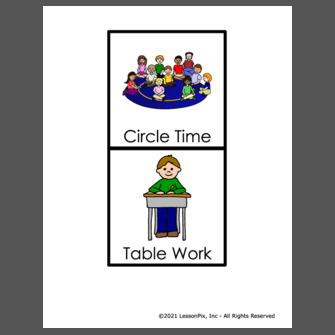
Recently, I found myself contemplating the importance of symbols in our lives. For many of us, picture symbols, like PECS, have helped smooth the way to communication with our loved ones. When my son Kieran was in school, I had to rely upon his speech therapist to create them. Now there are more options. A great low-cost resource for a similar picture system can be found at LessonPix.
Symbols, while helpful, can be controversial. Kieran loves the rainbow LGBTQ flag and can’t understand why everyone does not. For many, particularly parents, the Autism ribbon is a totem of Autism awareness and acceptance. Many Autistic adults, however, find it insulting and advocate for other symbols, including a multi-colored infinity sign. The Autism Society has not used the ribbon logo for many years due to this controversy.
At a recent ASO Board meeting, Thomas McKean, who served with Temple Grandin on the Autism Society Board, provided us with the history of the ribbon. We thought it might be interesting to share his viewpoint with you as our guest columnist this month.
Kathi J. Machle, President, Autism Society of Ohio
Hello, I’m Thomas. Back in the 90’s, I served on the national board of directors of the Autism Society of America. During that time, I was involved in the creation of Autism Awareness Month and the puzzle piece ribbon awareness symbol. It is this symbol that I have been asked to write about.
As some of you know, the symbol has come under fire recently. I was there at the creation of it, I had input and a vote on it, and I used both. I am the only one with Autism who was involved with its adoption as a symbol. The symbol has my DNA in it, so let me take a moment to tell you where we’re coming from and what it represents.
Some will tell you that it represents those of us with Autism as missing pieces within ourselves. This is misinformation. Not only did we never discuss that, it was never even brought up. Others will tell you that it represents Autistics as missing pieces. But this also never came up in conversation.
The interlocking puzzle pieces represent the complexities of Autism — not any particular individual who has been diagnosed, but the condition of Autism itself. Even now, 26 years later, we have come understand more about Autism, but some of it still remains a mystery.
The different colors of the puzzle piece represent the many with Autism and the diverse forms it takes. From the ones with homes and families and jobs and degrees, down to the kids who, even as I type this, are banging their heads alone in dark, otherwise quiet corners of institutions, to everyone in between. The various colors represent them all.
The brightness of the colors represents hope. Not hate, as some of you have been told, but hope. Hope that one day we figure this out. Hope that we can end the screaming and the banging of heads in the institutions or at home. Hope that one day, we will all find a way to communicate. Hope that we will one day move from awareness to acceptance. Hope that one day we’ll have diagnostic criteria, treatment and support that make sense.
So let me repeat this last part – the brightness of the colors represents hope. Not hate, but hope.
This is what the symbol means – officially. As with every other symbol, some have assigned their own meaning to it. Meanings such as their child is the piece that completes the family or recognition that Autism is still somewhat puzzling. This is not a symbol of hate, we created it as a symbol of respect toward the Autistic population.
Regardless of how any of us may feel about the symbol, I believe we have more important things to focus on.
Education and employment…
Housing and health care…
Funding and awareness…
…to name just a few. While I would be okay changing the symbol, that priority is low on my list. I’d rather we currently focus on things that will create a positive change in the lives of those diagnosed with Autism and creating unity within the Autism community. To me, that’s what advocacy is about.
Member, board of directors of the Autism Society of Ohio and co-creator of the autism puzzle piece.
Thomas A. McKean was diagnosed in 1979. Following three years in an institution, he began advocating for autism. He has traveled all across the US and Canada to speak at conferences and consult for families and schools, and he has appeared on Oprah and NPR. He is the author of the award-winning Soon Will Come the Light and he currently makes a home in Hilliard, OH.
